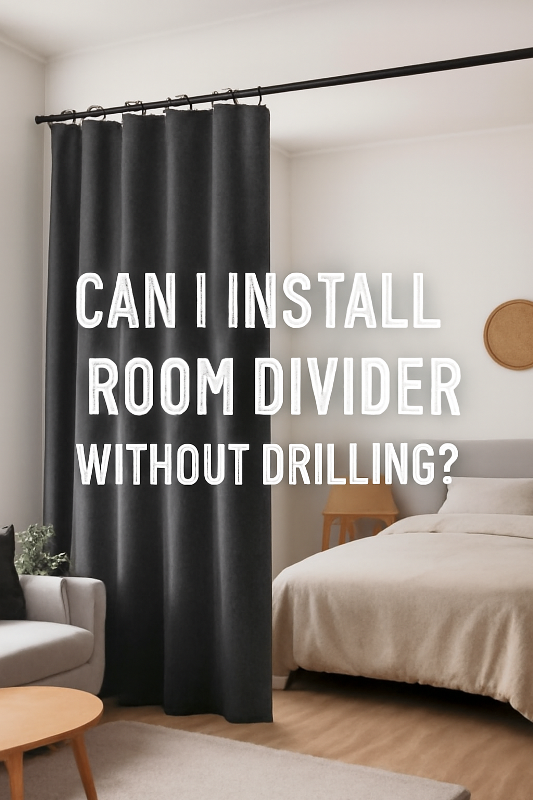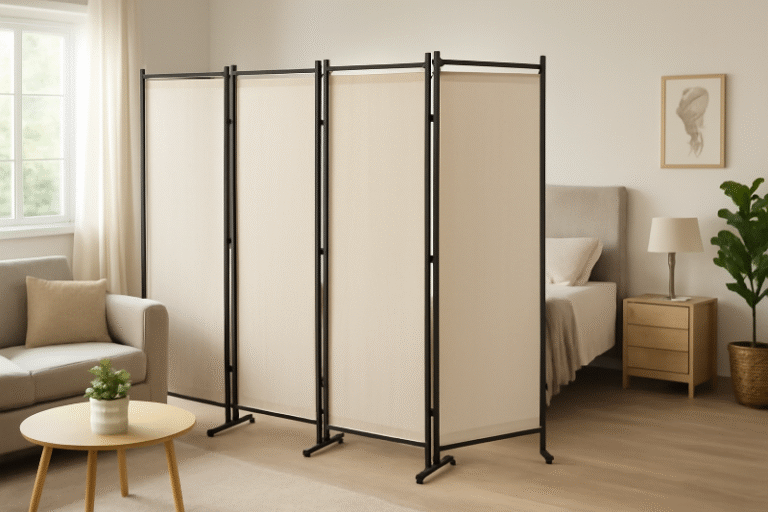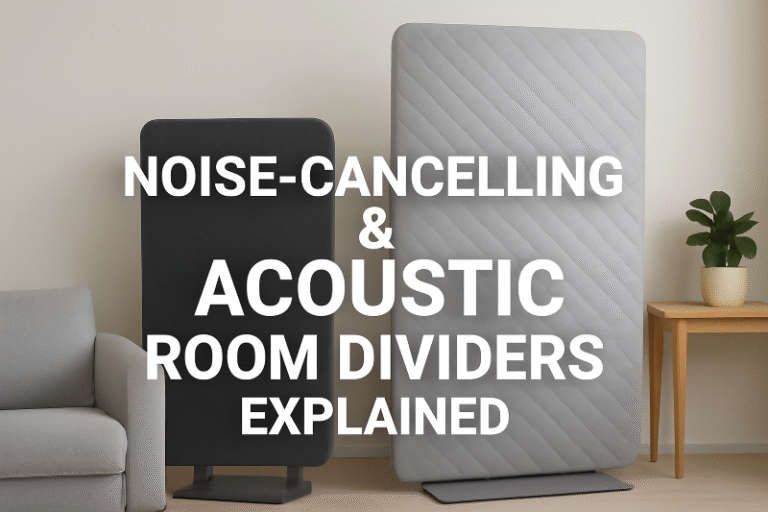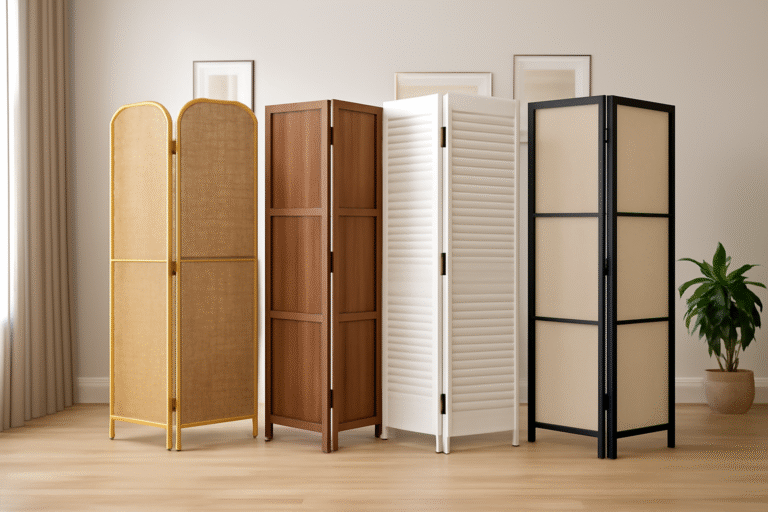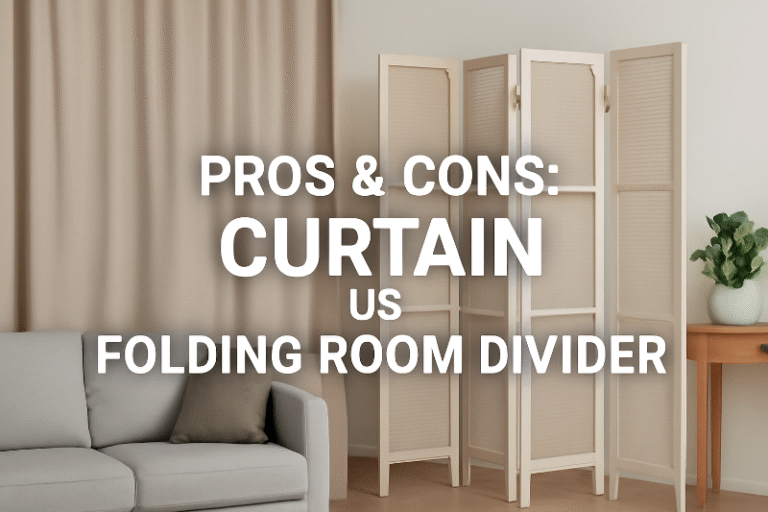Room dividers are a great way to enhance privacy, organize space, and add aesthetic value to a room. However, one common concern is whether they can be installed without causing damage to the walls or the need for drilling. Whether you’re renting or simply prefer not to put holes in your walls, the good news is that there are plenty of non-drilling solutions available. Here’s a guide to the different types of room dividers you can use without drilling, along with some practical tips for installing them in your space.
1. Tension Rod Dividers
How It Works:
A tension rod is a popular, simple, and effective solution for dividing spaces without drilling. This device uses adjustable rods that rely on tension to hold in place, typically between two walls or the ceiling and floor. No tools are required to install it, and it can be easily removed or repositioned.
Best For:
- Curtain Dividers: Hang lightweight fabric curtains, drapes, or sheer panels from the tension rod to create a soft, movable partition. This works particularly well in living rooms, bedrooms, or studios where you want a quick and flexible solution.
- Temporary Dividers: Ideal for renters or anyone who doesn’t want to leave permanent marks or holes in their walls.
Pros:
- Easy to install and remove.
- No damage to walls.
- Affordable.
- Customizable with fabric colors and designs.
Cons:
- Not suitable for heavy-duty partitions.
- Less soundproofing compared to solid walls or panels.
2. Freestanding Room Dividers
How It Works:
Freestanding room dividers are self-supporting and do not require attachment to walls, ceilings, or floors. These dividers are usually made from lightweight materials like fabric, wood, or metal and can be moved and placed wherever you need them. They come in many forms, such as folding screens, bookcases, or even plants.
Best For:
- Flexible Room Layouts: Use them to separate areas within a room or to create temporary partitions. Freestanding dividers are perfect for spaces where you want a partition that’s not fixed.
- Offices & Living Areas: They’re ideal for home offices, bedrooms, or studio apartments where dividing space without installation is needed.
Pros:
- No installation required.
- Portable and flexible.
- Can be used in various layouts.
Cons:
- May take up more floor space.
- Might not provide complete privacy or soundproofing.
- Some models may be less stable, especially in high-traffic areas.
3. Adjustable Floor-to-Ceiling Screens
How It Works:
Adjustable floor-to-ceiling screens use a spring mechanism or tension to stay in place, spanning between the floor and ceiling. This option doesn’t require drilling into the walls or ceiling, as it uses pressure to hold the screen steady. These are often designed as sleek, modern partitions that blend well into contemporary décor.
Best For:
- Temporary Zoning: Perfect for dividing open spaces without the need for structural changes, such as in offices, large living rooms, or dining areas.
- High Ceilings: Ideal for rooms with high ceilings, as they can be adjusted to fit various ceiling heights.
Pros:
- Adjustable for different room sizes.
- No damage to walls or ceiling.
- Aesthetic and modern look.
Cons:
- Can be pricier than other non-drilling options.
- Takes up vertical space, which might not be suitable for rooms with lower ceilings.
4. Magnetic Room Dividers
How It Works:
Magnetic room dividers use magnetic strips or systems that can adhere to metal surfaces. These dividers are typically made of fabric or lightweight panels with embedded magnets, which allow them to attach to any metallic surface, such as a metal beam or frame. No drilling is necessary, as the divider simply “snaps” into place.
Best For:
- Industrial-Style Interiors: Works well in spaces with exposed metal beams or metal framing, where traditional dividers might not be practical.
- Minimalist Spaces: Offers a clean, no-fuss look in offices or open-plan areas.
Pros:
- Easy to install and move.
- Minimalistic and modern.
- No wall damage.
Cons:
- Limited to environments with metal surfaces.
- May not be as flexible as other non-drilling options.
5. Hanging Room Dividers
How It Works:
Some room dividers are designed to hang from a ceiling-mounted track system that doesn’t require drilling into walls. These systems usually consist of a ceiling-mounted rail or hook from which fabric or screens can hang. The divider can then be pulled across the room to create a partition.
Best For:
- Temporary Bedroom or Office Dividers: Ideal for renters who want to separate spaces without leaving permanent marks.
- Ceiling Space: Works well in rooms with high ceilings or where wall mounting is not an option.
Pros:
- Easy to install and reposition.
- Offers a soft, flowing design.
- Ideal for light, fabric-based dividers.
Cons:
- Ceiling installation is required.
- May not offer as much privacy as solid dividers.
6. Bookcase or Shelving Units
How It Works:
Bookcases and shelving units can serve as dual-purpose room dividers and storage solutions. These units are placed between two areas to create separation while providing a functional and stylish storage space. They don’t require drilling and can be moved around as needed.
Best For:
- Home Offices and Living Rooms: Use a bookcase to separate an office area from a living room or dining space.
- Multifunctional Spaces: Great for creating storage and division simultaneously in small apartments or studio apartments.
Pros:
- Provides storage in addition to being a divider.
- No drilling required.
- Can be easily rearranged.
Cons:
- May not provide complete sound isolation.
- Can take up significant floor space.
7. Sliding or Folding Room Dividers
How It Works:
Sliding or folding room dividers can be installed without drilling by using a tension rod, retractable system, or track mounted on the ceiling. These dividers are versatile, and their panels slide or fold to open up or divide the space when needed. They are available in a wide variety of materials, including fabric, wood, and glass.
Best For:
- Temporary and Flexible Room Division: Great for spaces that need an easily reconfigurable partition.
- Living Rooms and Studios: Perfect for studio apartments where you want to create separate spaces without permanent alterations.
Pros:
- Flexible and space-efficient.
- No drilling into walls required.
- Sleek, modern look.
Cons:
- Ceiling installation may be required for some designs.
- May not provide the same level of privacy or soundproofing as solid walls.
Conclusion
In today’s design world, there are plenty of innovative ways to install room dividers without the need for drilling into walls or ceilings. From tension rods to freestanding dividers, the options are abundant for those who want to create defined spaces without permanent alterations. The right choice depends on your needs – whether it’s flexibility, soundproofing, privacy, or aesthetics. Whether you’re a renter, working in a temporary space, or just prefer not to damage your walls, these non-drilling room divider solutions provide a practical and stylish way to create the perfect partition in your home or office.
